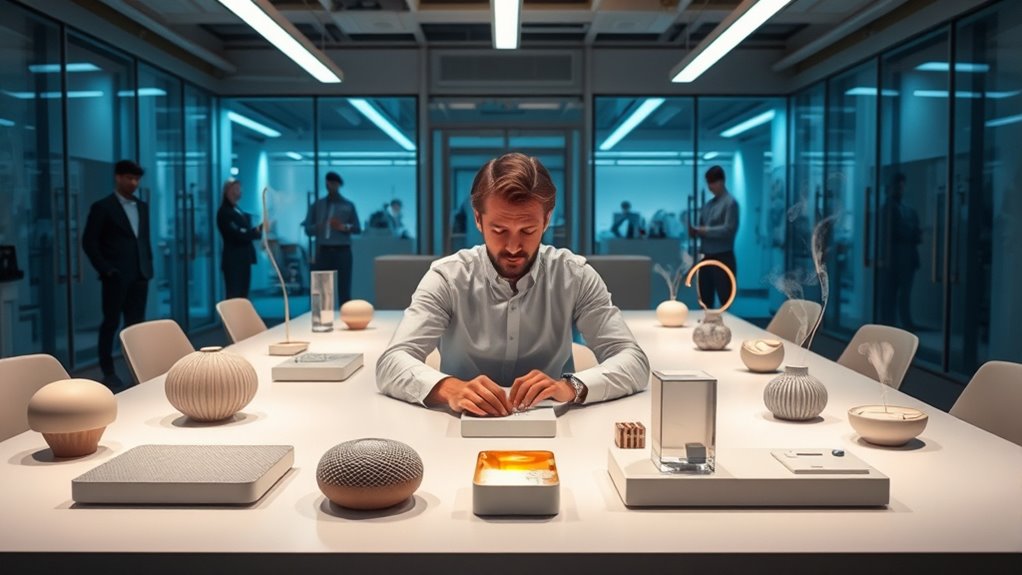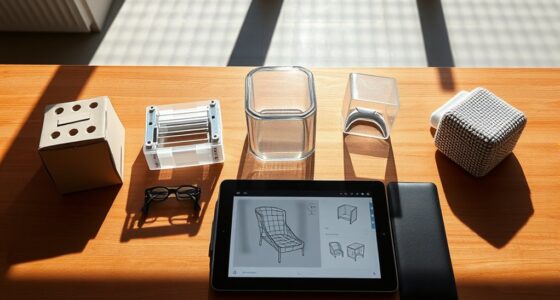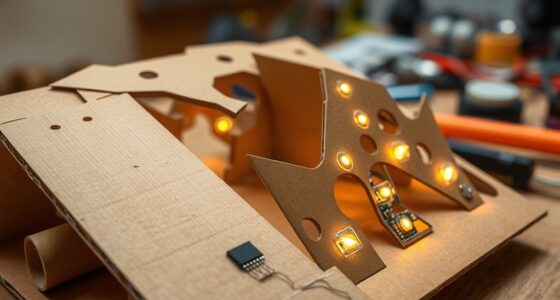Multisensory prototypes go beyond just sight and sound by incorporating touch, smell, and even taste to create richer user experiences. These methods help you gain deeper insights into how users perceive and connect with products emotionally. By using tactile surfaces, scents, and haptic feedback, you can enhance engagement and recall. Exploring these multisensory approaches opens new avenues for immersive testing—you’ll uncover even more ways to refine your designs as you continue exploring.
Key Takeaways
- Multisensory prototypes incorporate touch, smell, and taste to create more immersive and emotionally engaging user testing experiences.
- Integrating diverse sensory cues enhances user insights, brand connection, and overall perception of products or environments.
- Challenges include balancing sensory elements, managing complexity, and ensuring coherence across senses for authentic experiences.
- Advanced technologies like electronic noses and taste simulators enable precise control of multisensory stimuli in prototypes.
- Future trends point to multisensory prototypes becoming standard, enriching virtual environments and deepening user engagement beyond sight and sound.
The Evolution of User Testing: Moving Beyond Visual and Auditory Cues
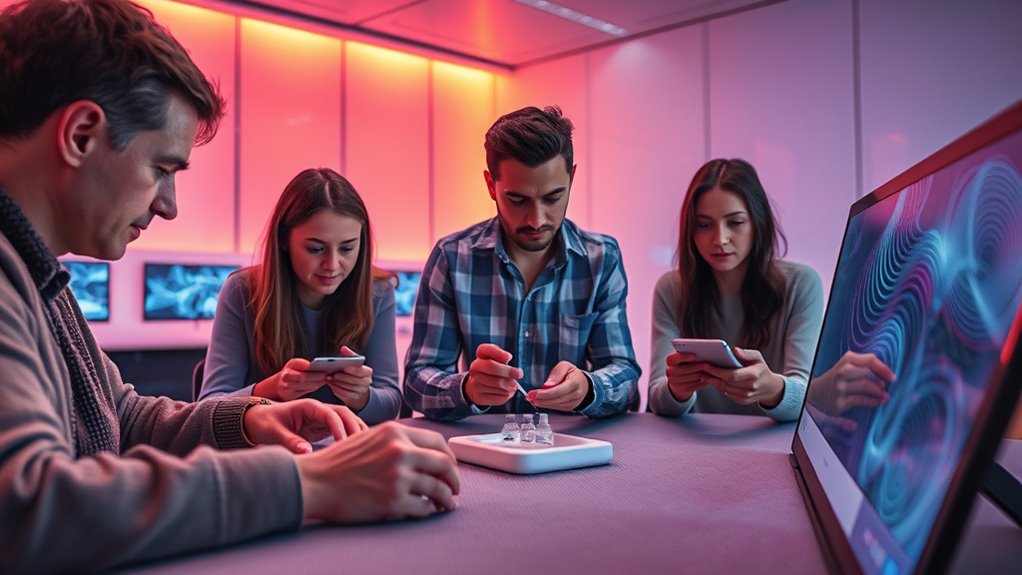
Although traditional user testing has primarily focused on visual and auditory feedback, recent advancements reveal the importance of incorporating other senses to better understand user interactions. Sensory marketing explores how different senses influence consumer behavior, emphasizing the role of touch, smell, and taste. By applying principles of cross modal perception, you can create more immersive and intuitive prototypes. This approach recognizes that our senses are interconnected, meaning a change in one can affect perceptions in others. Moving beyond sight and sound allows you to gather richer insights into how users experience products, leading to more effective designs. Incorporating multisensory elements in testing enhances engagement and helps you identify subtle reactions that traditional methods might overlook. Ultimately, this evolution broadens your understanding of user needs and preferences.
Understanding the Power of Multisensory Engagement in Design
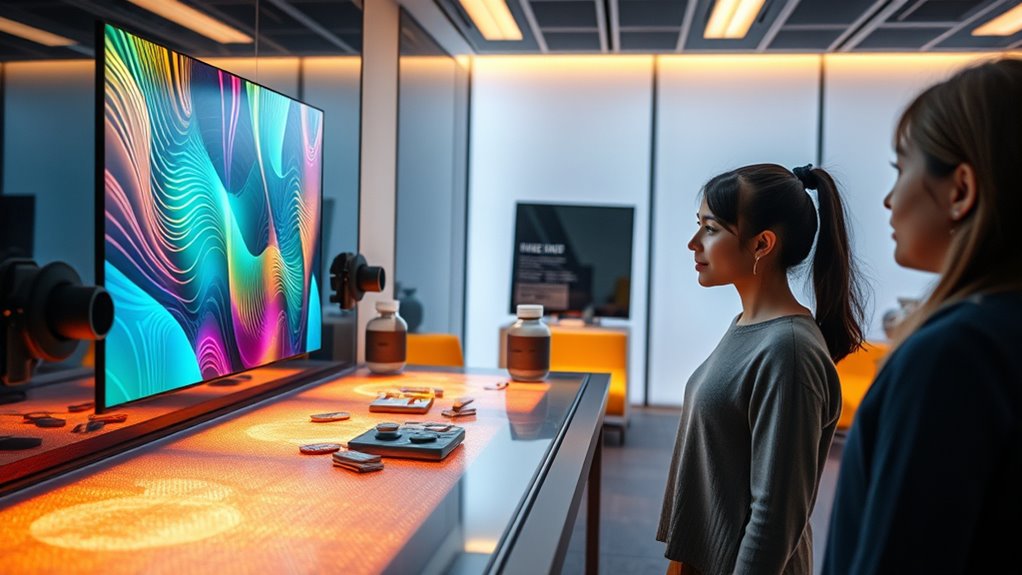
Have you ever noticed how a pleasant scent or a satisfying texture can deepen your connection with a product? That’s the power of multisensory engagement. In design, sensory branding uses multiple senses to create memorable experiences that resonate emotionally. Multisensory marketing taps into these cues, making products more appealing and fostering brand loyalty. When you activate more senses, you don’t just see or hear; you feel, smell, and touch, which enhances user perception and engagement. This approach goes beyond traditional visuals, creating richer, more immersive interactions. By understanding how different senses influence decision-making and emotional response, you can craft designs that truly connect with users on a deeper level, elevating your overall user experience through multisensory prototypes. Incorporating cookie categories and user consent management further supports creating personalized, engaging experiences that respect user preferences.
Practical Applications of Tactile and Olfactory Prototypes
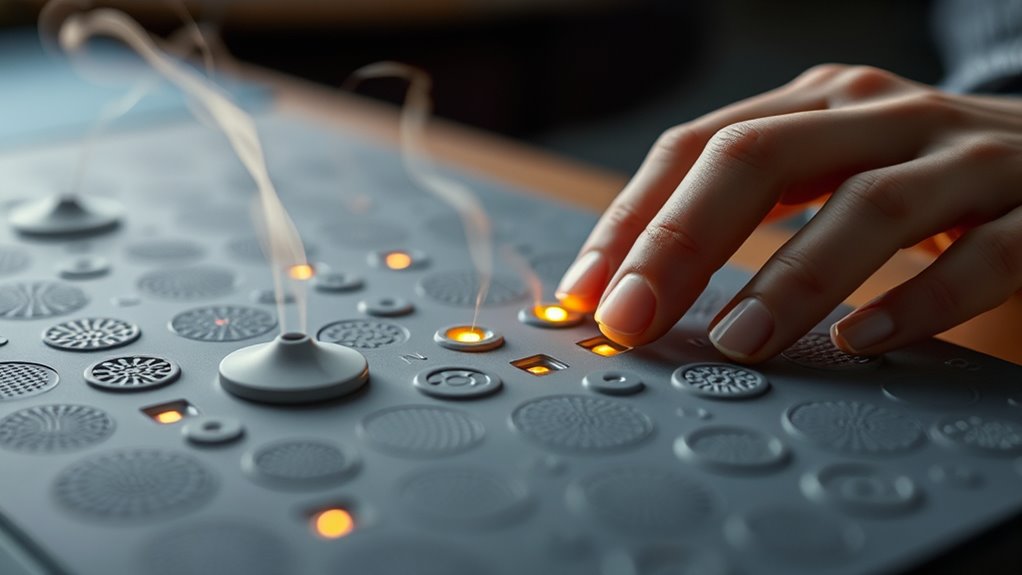
Tactile and olfactory prototypes can considerably improve your design process through material testing and environment simulation. By incorporating these sensations, you can create more engaging and realistic user experiences. Exploring these applications helps you develop products that resonate deeply with users on multiple senses. Incorporating sensory feedback in prototypes can also enhance emotional engagement and user satisfaction.
Tactile Material Testing
When testing tactile materials, researchers focus on how you perceive texture, firmness, and surface quality to guarantee prototypes meet sensory expectations. Haptic feedback plays a crucial role, providing you with physical sensations that help you distinguish between different materials. During material exploration, you assess how the surface feels under your fingertips, noting variations in roughness, smoothness, or softness. This process ensures the prototype delivers realistic tactile cues, enabling you to evaluate its suitability for intended use. You might also test how the material responds to pressure or deformation, ensuring it provides consistent feedback. By carefully analyzing these tactile interactions, designers can refine prototypes to evoke authentic sensory responses, ultimately improving user experience in multisensory environments. Recognizing the importance of fatherhood and nurturing bonds can also inspire more empathetic and user-centered design approaches.
Olfactory Environment Simulation
Integrating olfactory environment simulation into prototype testing allows you to create more immersive and realistic multisensory experiences. By incorporating scent marketing and olfactory branding strategies, you can evoke specific emotions and strengthen brand associations. Using scent diffusers or scent cartridges, you simulate environments that align with your product’s identity, enhancing user engagement. This approach helps you test how different fragrances influence user perceptions, comfort, and decision-making. Olfactory cues can trigger memory and emotional responses, making your prototypes more compelling. When carefully designed, scent marketing can reinforce your brand message and set the mood for your user experience. Additionally, understanding the color accuracy of your visual elements ensures that your multisensory setup aligns with the overall aesthetic, creating a cohesive sensory environment. Overall, olfactory environment simulation offers a powerful tool to deepen user immersion and gather valuable insights into sensory interactions beyond sight and sound.
Enhancing User Engagement
By leveraging tactile and olfactory prototypes, you can substantially boost user engagement by creating more immersive and memorable experiences. Incorporate haptic feedback to make interactions feel more real and responsive, encouraging users to stay engaged longer. For example, subtle vibrations or textured surfaces can enhance product testing and user satisfaction. Additionally, scent branding taps into the emotional power of smell, reinforcing brand identity and fostering a deeper connection. When combined, tactile and olfactory cues make interfaces more compelling and intuitive. These multisensory elements not only attract attention but also improve recall and emotional response. Understanding asset division principles can inform how various sensory cues are balanced and allocated within prototypes, ensuring a harmonious user experience. By thoughtfully integrating haptic feedback and scent branding, you elevate user engagement beyond traditional visual and auditory methods, making your prototypes more dynamic and impactful.
Enhancing Memory and Emotional Connection Through Multisensory Methods
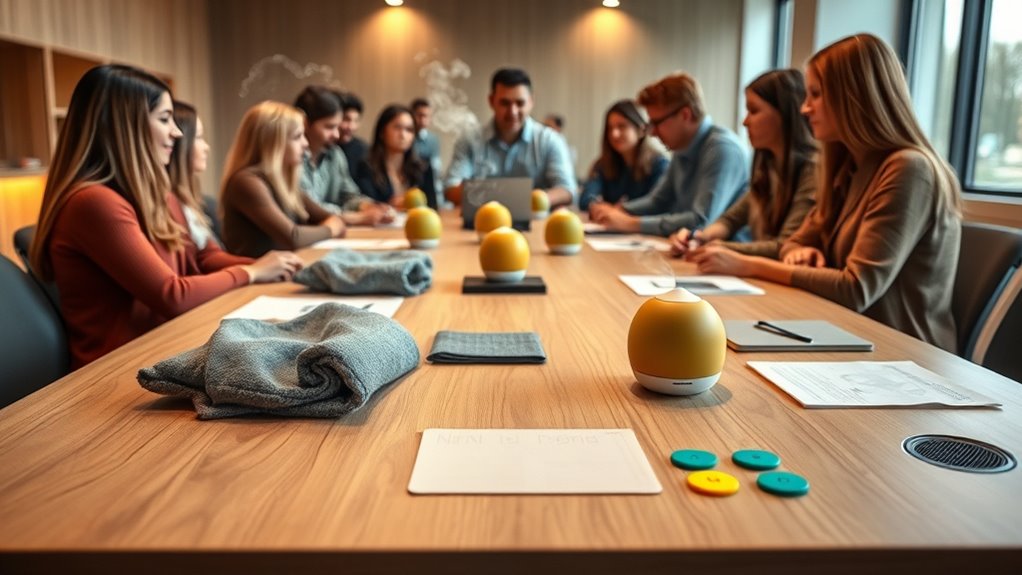
Multisensory methods can considerably boost your ability to remember information and deepen emotional connections. By engaging multiple senses, you reinforce sensory branding, making experiences more memorable. When you incorporate sights, sounds, textures, tastes, and smells, you create a richer context that enhances emotional memory. This connection helps users associate positive feelings with your product or brand, fostering loyalty and trust. For example, a specific scent or tactile element can evoke nostalgia or comfort, strengthening emotional bonds. Using multisensory cues intentionally makes your message more impactful and memorable. When designing prototypes, focus on how each sensory element can trigger emotional responses. This approach not only improves recall but also deepens the emotional engagement users feel, making your experience more compelling and enduring. Incorporating dog names or other familiar concepts can further personalize and enhance the multisensory experience.
Challenges and Considerations in Developing Multisensory Prototypes
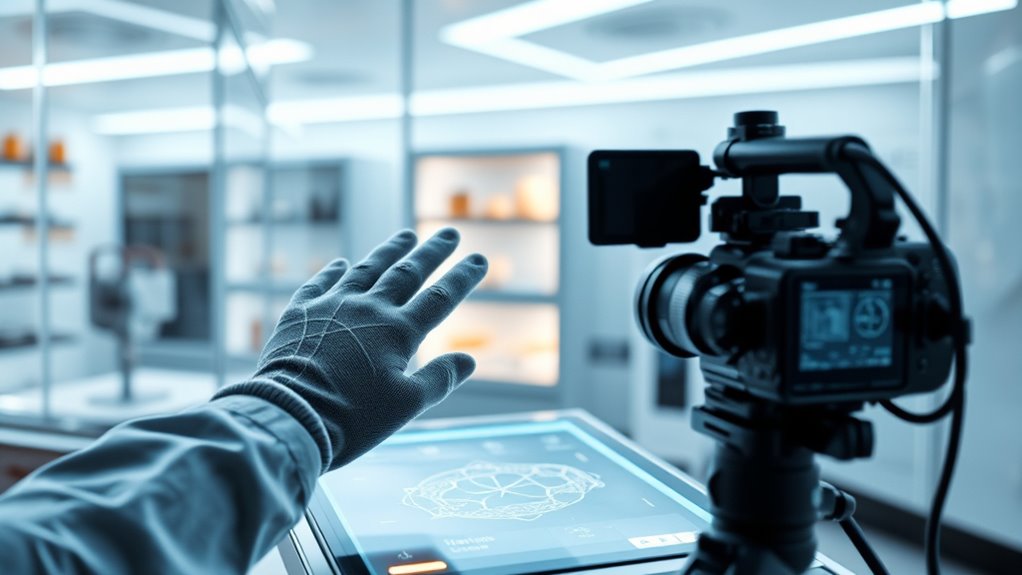
Creating effective multisensory prototypes presents several challenges, as aligning multiple sensory elements requires careful planning and execution. Sensorial limitations can hinder your ability to replicate certain sensations accurately, making it difficult to achieve authenticity. Additionally, prototype complexity increases as you incorporate more senses, which can lead to technical difficulties and higher development costs. Managing these complexities demands thoughtful integration to guarantee each sensory component complements the others without overwhelming users or causing confusion. You must also consider the variability in individual perceptions, which can affect consistency across users. Balancing sensory richness with usability is vital. Furthermore, understanding the Best Heat Pump features and potential limitations can inform more effective multisensory design choices. Ultimately, overcoming these challenges requires strategic design choices, thorough testing, and an understanding of sensory interactions to create prototypes that are both immersive and practical.
Future Trends: Integrating Taste and Smell for Immersive User Experiences
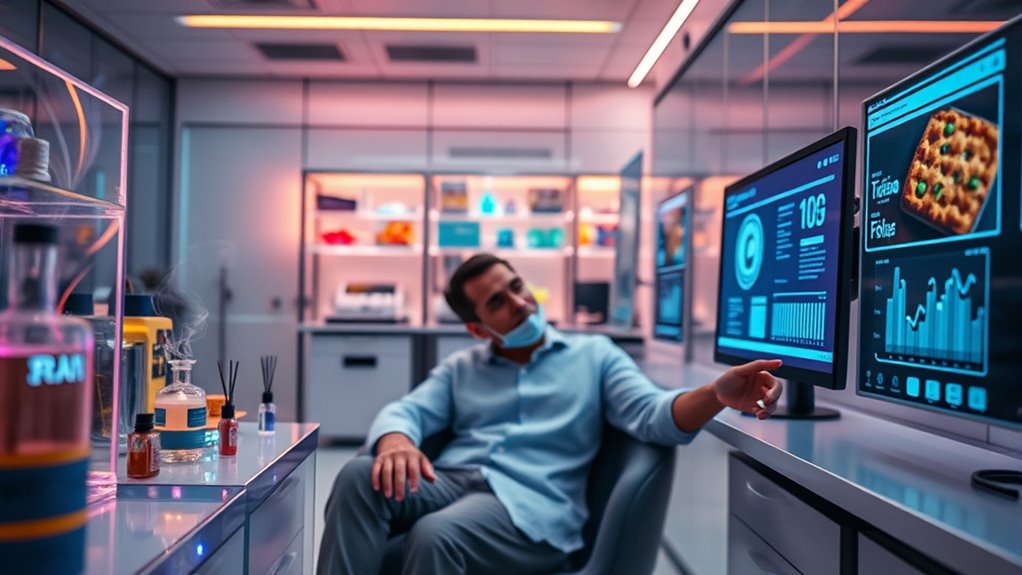
Advancements in technology are opening new possibilities for incorporating taste and smell into immersive experiences, moving beyond visual and auditory stimuli. As taste testing and scent integration become more sophisticated, you can create more engaging and realistic environments. Future trends include using electronic noses and taste simulators that mimic flavors and aromas, enhancing user interaction. These innovations allow for more precise control over multisensory stimuli, making virtual environments feel more authentic. By integrating scent and taste, you can evoke emotions more effectively and improve user engagement in applications like gaming, training, or therapy. As these technologies evolve, expect multisensory prototypes to become a standard part of immersive user experiences, transforming how you perceive and interact with digital content. Incorporating multisensory stimuli into design can also contribute to more memorable and emotionally impactful experiences.
Frequently Asked Questions
How Can Multisensory Prototypes Be Integrated Into Virtual Reality Environments?
You can integrate multisensory prototypes into virtual reality by adding haptic feedback to simulate touch and tactile sensations, making experiences more immersive. Incorporate spatial audio to provide realistic sound cues that change with your position and orientation. These elements work together to enhance user engagement, allowing you to feel and hear the environment, ultimately creating a more compelling and realistic VR experience that goes beyond just sight and sound.
What Ethical Considerations Arise When Using Olfactory or Gustatory Stimuli in Testing?
Imagine experiencing a scent or taste during testing, but you might not realize its full impact. You need to contemplate consent complexities, ensuring users fully understand what stimuli they’ll encounter. Cultural sensitivities also matter—what’s harmless in one culture could be offensive in another. Respecting privacy, avoiding discomfort, and providing clear information are key ethical considerations when incorporating olfactory or gustatory stimuli into user testing.
Are There Cost-Effective Methods for Developing Multisensory Prototypes at Scale?
You can explore cost-effective methods for developing multisensory prototypes by leveraging scalable development techniques like modular design and digital simulations. Using affordable materials, 3D printing, and virtual reality tools helps you create realistic prototypes without high expenses. Collaborating with multidisciplinary teams and focusing on iterative testing allows you to refine your multisensory experience efficiently. These approaches ensure you develop scalable, budget-friendly prototypes that effectively test sensory interactions.
How Do Individual Differences Affect Multisensory Perception During User Testing?
You should consider that individual differences and sensory variability markedly influence multisensory perception during user testing. These factors mean that each user may perceive stimuli differently based on their sensory sensitivities, experiences, or conditions. To get accurate insights, tailor your testing to account for these differences, perhaps by including diverse participants or customizing stimuli. Recognizing this variability helps you design more inclusive prototypes and better interpret user responses.
Can Multisensory Prototypes Improve Accessibility for Users With Sensory Impairments?
Imagine a key unfastening a door—that’s how multisensory prototypes can open new pathways for accessibility. You can harness sensory customization to tailor experiences, making interfaces more inclusive for users with impairments. By integrating impairment accommodations into prototypes, you guarantee everyone can navigate your design with confidence. This approach transforms user testing into a bridge that connects diverse needs, creating a more equitable digital environment for all.
Conclusion
Just as the sirens’ allure went beyond sight and sound, embracing multisensory prototypes *unlocks* richer user experiences. By engaging touch, smell, and taste, you create deeper connections and memories—transforming design from mere function to an immersive journey. As you venture beyond traditional cues, remember that the future belongs to those who harness all senses, echoing the timeless idea that true innovation comes from exploring uncharted sensory territories.
